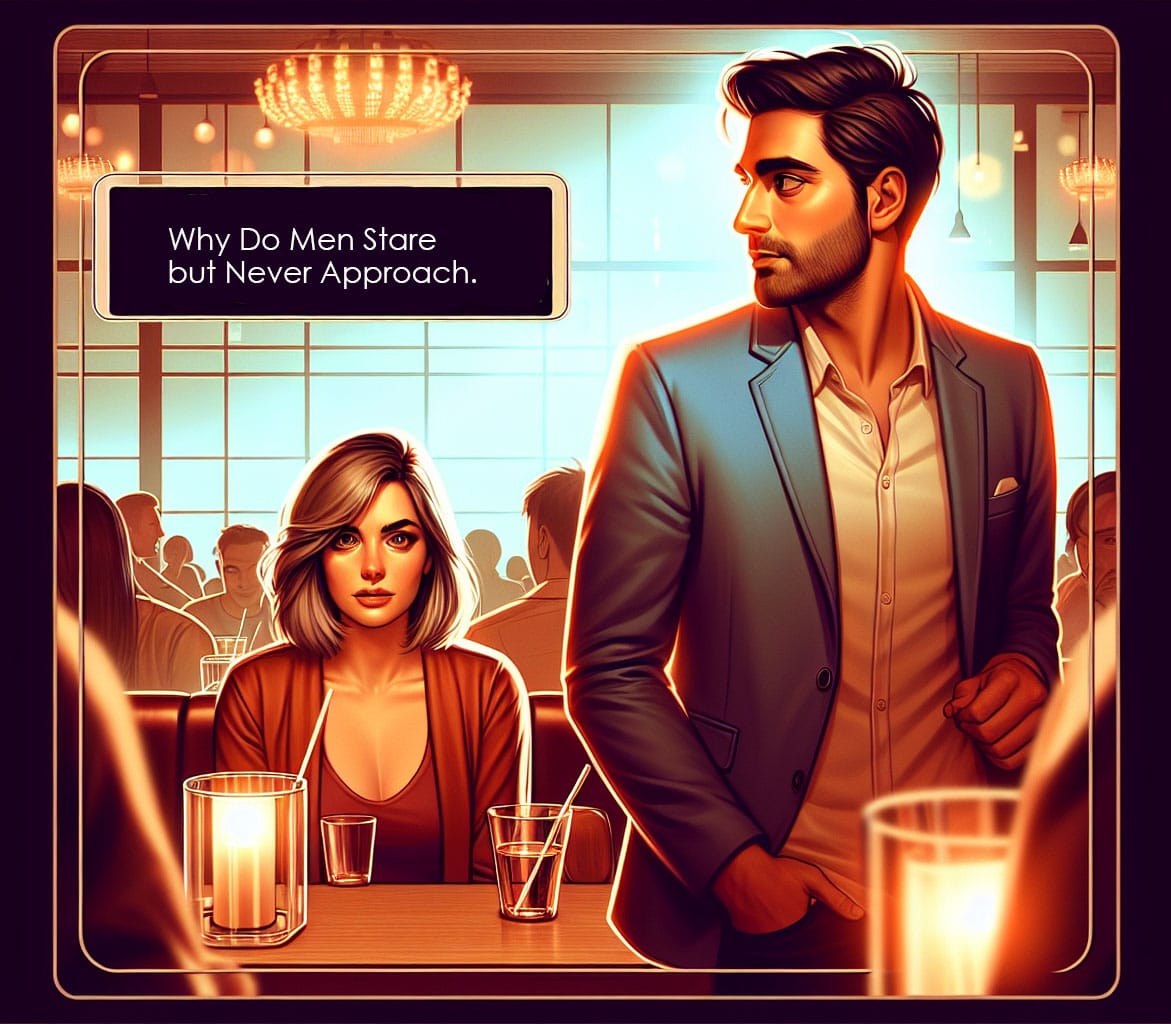It’s a familiar, often frustrating scenario: you’re out somewhere, you catch someone looking at you, maybe even hold their gaze for a brief second. You think, “Okay, maybe they’ll come over…” but then… nothing. They look away, walk off, or just continue to stare from afar. It happens all the time and leaves many wondering, “What’s going on in their head?”
This “look but don’t leap” phenomenon is a fascinating aspect of social behavior. Today, we’re diving deep into the reasons behind it, drawing insights from discussions, analyses like Andrew Kuo’s popular video “Five Reasons Guys Stare But Don’t Approach,” and real experiences shared online. Our goal is to provide clarity and perhaps shift your perspective the next time it happens.
The Overwhelming Fear of Rejection
This is arguably the most significant factor that came up repeatedly. Approaching someone, especially a stranger, is inherently vulnerable.
The Immediate Sting of “No”

Nobody enjoys rejection. The immediate fear of getting a negative response – a dismissal, disinterest, or an outright “no” – can be paralyzing. As Andrew Kuo points out, putting yourself on the line like that is a big risk.
Public Humiliation & Social Anxiety
The fear intensifies if friends are around. A rejection isn’t just personal then; it feels like public humiliation. Some commenters, like John Cook, even described this as a fear of “social assassination” – being completely ridiculed or facing harsh social judgment, not just a simple refusal. This highlights the significant anxiety many feel about approaching someone new.
The Impact of Dating Apps
Kuo connects this fear to the rise of dating apps. On apps, there’s an implicit understanding that both parties are open to meeting someone. This removes some of that initial, raw fear of being completely shot down, which is ever-present in spontaneous, in-person approaches.
The Pain of Regret (“What Ifs”)
Interestingly, the fear of rejection can sometimes be overshadowed by the regret of *not* taking a chance. One anonymous commenter powerfully stated, “give it a try because healing from rejection is much easier than healing from what ifs.” This underscores the internal conflict many face.
Social Context & Environmental Barriers
The situation and surroundings play a crucial role in whether an approach happens.
The Intimidation of Groups
Approaching someone who is part of a group is significantly more intimidating than approaching someone alone. The stakes feel higher because you’re not just facing potential rejection from one person, but the judgment or reaction of the entire group. Friends can act as supportive “wingmen” or protective “blocks,” and it’s impossible to know which dynamic you’ll encounter.
Pro-Tip (from Kuo): If you’re in a group and hoping to be approached, briefly stepping away (e.g., to the bar) can make you seem more accessible for a one-on-one conversation.
The “Are They Together?” Dilemma
If you’re with another person, especially a guy, many will automatically assume you’re a couple, even if you’re just friends. People generally want to avoid the awkwardness or disrespect of interrupting a potential couple. Signaling you’re *not* romantically involved (Kuo humorously suggests an awkward high-five) can sometimes help, as can avoiding overly flirty interactions or excessive physical contact with your platonic friend.
Physical Inaccessibility & Environment
Sometimes, it’s purely practical. If someone is surrounded by a dense crowd, if there are physical obstacles, or if the music is deafeningly loud, the sheer effort required to initiate and sustain a conversation might seem too high. It becomes a subconscious cost-benefit analysis: the hassle outweighs the potential reward.
Perceptions, Assumptions & Internal Narratives
What the person *thinks* about you or the situation heavily influences their actions (or lack thereof).
Perceived Intimidation Due to Attractiveness
Counterintuitively, being perceived as very attractive can sometimes make you *less* approachable. This ties into the “out of my league” mentality mentioned by John Cook and others. Guys might assume:
- You have countless options and wouldn’t be interested in them.
- You’re already taken.
- You have impossibly high standards.
This can lead to a “preemptive rejection,” where they admire from afar rather than risk confirming their perceived inadequacy. Ron William noted that men lacking self-confidence are particularly hesitant in these situations. Linda Filler also mentioned the common assumption that stunningly beautiful people are already in relationships.
Fear of Misinterpretation (Being Seen as Creepy)
Men are often conscious of not wanting to come across as creepy or bothersome. The fear of misinterpreting the situation or your interest, and subsequently making you uncomfortable, can be a major deterrent. Imagining all the ways the interaction could go wrong can be paralyzing.
Internal Fantasies & Getting Lost in Thought
Sometimes, as commenter OTC Creek humorously pointed out, guys might get caught up in elaborate romantic fantasies or internal scenarios in their heads but never actually act on them. They might just be observing, thinking, or even spacing out.
Shyness, Uncertainty & Simple Explanations
Not every stare is loaded with complex fear; sometimes, simpler factors are at play.
Simple Shyness or Awkwardness
Some people are just shy (as highlighted by Joyce Herron). It might not be outright fear of rejection, but rather a general awkwardness, not knowing what to say, or the fear of saying something stupid.
The “Nice Guy” Observation Phase
Jace Heron suggested some “nice guys” might observe first, trying to get a sense of your personality before committing to an approach.
Just Looking or Mistaken Identity
Let’s not forget the simplest explanations. Sometimes a stare is just a stare. They might be spacing out, lost in thought, or they might have momentarily mistaken you for someone else. Not every look carries deep meaning.
Your Signals (Intentional or Not)
Your own body language plays a role in approachability.
Sending “Stay Away” Vibes
You might unintentionally be sending signals that you’re closed off or disinterested. Looking down, avoiding eye contact, crossing your arms, or appearing engrossed in your phone can nonverbally tell people not to approach. John Cook and others emphasized this point.
The Power of “Green Lights”
Conversely, sending positive signals (“green lights” as Kuo calls them) can make a significant difference. Simple actions like:
- Making eye contact (even briefly)
- Smiling
- Having open body language
These act as subtle invitations, giving potential approachers a feeling of permission and reducing their perceived risk. Sameer Bakuri also talked about giving “choosing signals” to make it clear you’re open to interaction.
Crossed Wires & Miscommunication
Sometimes, signals get misinterpreted entirely. Jace Heron noted a funny scenario where a guy might think *you’re* the one interested and is trying to decipher *your* signals, leading to mutual inaction. It can be a classic case of crossed wires.
Summary Table: Key Reasons for Looking But Not Approaching
| Category | Specific Reason | Brief Explanation |
|---|---|---|
| Fear & Anxiety | Fear of Rejection | Direct fear of being turned down or dismissed. |
| Public Humiliation | Fear of being rejected in front of others (friends, onlookers). | |
| Social Anxiety / Awkwardness | General shyness, not knowing what to say, fear of saying something stupid. | |
| Fear of Misinterpretation | Worrying about being perceived as creepy or misreading the situation. | |
| Social Context | Group Intimidation | Approaching someone in a group is harder than approaching an individual. |
| Presence of Another Guy | Assumption the person is already taken or in a couple. | |
| Physical Barriers | Environment makes approaching difficult (crowds, noise, distance). | |
| Perceptions & Assumptions | Intimidation by Attractiveness | Feeling the person is “out of their league” or wouldn’t be interested. |
| Assuming Unavailability | Belief the person is likely already in a relationship. | |
| Internal Narratives | Getting lost in thought, fantasies, or simply observing. | |
| Your Signals | Perceived Lack of Interest | Reading body language as closed off or disinterested. |
| Missed/Unclear Signals | Not receiving clear “green lights” (smile, eye contact) to proceed. | |
| Simple Reasons | Spacing Out / Mistaken Identity | The look wasn’t intentional or directed specifically with romantic intent. |
What Does This Mean For You? Shifting Your Perspective
Understanding these varied reasons reveals a crucial point: someone staring but not approaching is rarely a reflection on your worth or attractiveness. More often than not, it’s about *their* internal state – their anxieties, perceptions, fears, and the social context they’re navigating.
- It’s (Usually) Not About You: Remember the complex web of fears and assumptions potentially holding them back.
- Be Aware of Your Signals: Consider if your body language might unintentionally seem closed off. A simple smile or sustained eye contact can be a powerful “green light.”
- The Power of Initiative: As the conversation concluded, consider this: what if *you* took a more proactive approach? making the first move first move, even just a simple “hello,” circumvents all their internal debate. As we heard, the regret of not trying can be potent. Who knows? You might spark a connection you would have otherwise missed.
The phenomenon of looking without approaching is complex, rooted deeply in human psychology, social dynamics, and individual insecurities. While it can feel perplexing or even dismissive to be on the receiving end, understanding the multitude of factors at play – primarily fear, social context, and internal assumptions – can help demystify the experience.
Ultimately, it’s about navigating the vulnerable space of potential connection. By recognizing the internal hurdles others might face and perhaps being willing to send clearer signals or even take the initiative yourself, you empower yourself within these common social scenarios.











